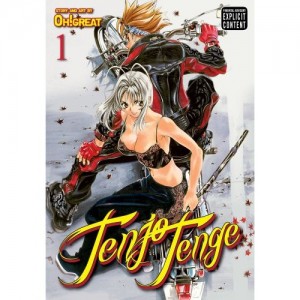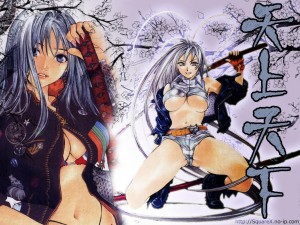Anime and Manga, A Cultural “Acting Out”
This is an adaptation of an article I wrote on July 31, 2000 for a website that no longer exists. I was a site administrator at the time, and one of the conditions of my position was to write…publish or perish, in fact. I was cranking out quite a few anime and manga reviews…and no one had a clue what I was writing about at the time. Anime was for creepy guys who wore t-shirts with Lum on them (it’s always Lum….) two sizes too small. Manga was unheard of. As a result, I received many questions about this “anime” stuff. Mostly “what the hell are you talking about?” In the past 11 years, quite a bit has changed; manga and anime blew up in global popularity, then the market blew up because it couldn’t sustain itself and now the industry is reconfiguring for a new century.
This essay was my answer to the most common question I received in 2000 and I think it’s worth revisiting once more. It’s applicable to most comics, in fact. Enjoy.
***
Of course, as I rant and rave about all the anime and manga I consume, I’m eventually asked, “what *is* it about this stuff that you like so much?”
I love that question. ^_^
For one thing, if there is a single quality that exists in anime/manga that nearly completely lacks in Western animation and comics, it has to be consistent character development. How many times can we see the gang in Scooby-Doo find that the bad guy wears a mask and was really the old caretaker, or have a new team, new costume, new continuity for our fave superhero, before we start to crave something more?
Over the course of a 26-episode anime series, or a 20-volume manga, the one thing I can practically count on is the emotional growth and complexity of all the characters – not just the hero/ine, but also the bad guy/girl, all the secondary characters and frequently tertiary characters as well.
But that’s not what this article is about. ^_^ This article is about all the *other* things I love so much in anime and manga – the qualities that make it so popular, and why it was inevitable that anime and manga be created specifically in a culture where there is a tremendous social pressure to conform.
 1) Anime/manga heroes are usually “different.”
1) Anime/manga heroes are usually “different.”
It is an axiom here in the west that we are all unique. Not so in Japan, where those who stand out are frequently pressured to conform by schoolmates, coworkers and family. “Pounding in the nail” is the OMG-overused-to-death phrase that is meant to express the collective desire to keep everyone at the same level. Very often the hero/ine of an anime or manga series is different – too tall, too short, bad at schoolwork, a complete brain. It doesn’t matter much – as long as the character stands out. Conversely, (and somewhat perversely) the character is occasionally average, but the circumstances of the series make them unusual – these series usually are filled with gags as the unwitting hero/ine attempts to seem “normal” as things around them fall apart. And, of course, many series portray a perfectly average hero/ine surrounded by many people of extraordinary looks and/or powers…frequently of the opposite sex.
Many people assume that anime/manga series are all pornographic. That is not at all the case. While Americans are obsessed with violence, but complete hypocrites when it comes to sex, the opposite is the rule in Japan – they tend to be more sqeuamish about violence than sex. Many of those things that we consider taboo are dealt with in a less Victorian manner in anime/manga.
Up until recent social pressures began to affect the laws of Japan, teenagers in Japan were assumed to be (or about to be) sexually active, and thus series’ directed at them often deal with sex and love in a reasonably direct way. Mind you – this doesn’t mean it’s realistic! From what I’ve seen, it pretty much ends up doing what western series do, portraying it as all violins, flowers floating by and hazy lighting, OR nasty, dirty, demonic sex. There rarely seems to be a happy medium.
Anime and manga often have gender-bending characters. Cross-dressers, gays or lesbians – some of the coolest characters in anime and manga are the bent ones. This does not mean that Japan is more accepting of these qualities in real life – just that it’s less threatening in *theory.* Plus, let’s face it – women look good in ties. ^_^ Also, strong emotional, even sexual relationships are considered relatively normal for Japanese kids – relationships that are left behind as part of their childhood when they get older and get married. It goes back to the sex thing – it just isn’t a scary concept.
 3) Magic and the occult are everywhere.
3) Magic and the occult are everywhere.
Another sticking point for many Westerners – Japan is not a Christian country. Their religion is primarily a shamanic one, centered around fertility and harvest festivals. Does this mean that the average Japanese salaryman believes in magic? No. No more than the average American office worker. But they like to see it in their entertainment! And so do I.
***
To sum up, from my years watching anime and reading manga, I’ve noticed that many of the themes dealt with in these media are *not* what the average Japanese person wants to cope with. The pressures of remaining in conformity with societal norms are rather enormous. I believe that many of the things that make anime and manga so popular are those very things that make life difficult. In effect, anime and manga are a giant cultural “acting out” of things that can’t be dealt with easily in real life.
For me, these qualities are some of the most attractive things about this particular form of entertainment.
***
Note: All pictures used in this article are from Tenjo Tenge, by Oh! Great, Shueisha and Viz Media. I picked them because I thought it would be amusing to do so as it embodies all of the qualities discussed and great heaps of violence.


Pingback: Thursday roundup « MangaBlog
Pingback: Love and Marriage: A Week’s Worth of Manga News » MTV Geek
What, no comments? This is the most interesting thing I’ve read about manga and anime for many months.
Incidentally, I wish there was a single word that meant “anime, manga and light novels”!